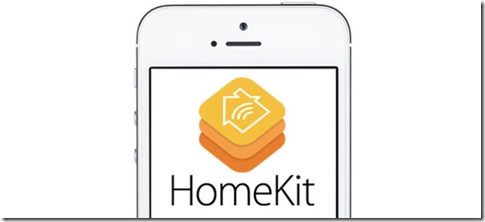From the outside, it may appear that HomeKit, Apple’s smart home solution, has progressed slowly since its initial unveiling at last year’s Worldwide Developer Conference event. The reality of the fact, however, is much different – in the “smart” home industry, it’s been an out-and-out battle between tech behemoths to improve upon the concept of smoothly connecting every digital aspect of the residential space. As additional HomeKit-enabled hardware options expand, Apple continues to charge forward as a powerful force in the home automation market.
What is HomeKit?
At the 2014 WWDC, the tech behemoth announced its decision to enter the smart home spotlight. HomeKit was introduced to the world as a framework which would simplify the current state of home automation – as one of the major global players in cellular device manufacturing and perhaps the most historically innovative tech-trendsetter, an efficient iOS-based system for home control would be truly game-changing.
The “HomeKit” is essentially a common language which allows smart devices from any manufacturer to communicate and work together. With HomeKit, Apple hopes to leverage its success in other tech markets to bring a comprehensive home platform to its legions of loyal consumers.
When using HomeKit, every component of the home – room, device, function, etc – has its own name to be therefore stored and recognized by Siri. Siri will then recognize and delegate the command when you audibly speak it. For example, if you want your washing machine to come alive and start the wash, you would name the appliance “washing machine” and the function “wash.” Siri can control all aspects of a HomeKit-enabled residence, so long as you have appropriately designated the names, it’s capable of “triggering” a series of actions or pre-set responses.
HomeKit can also sort home products by “scene” or even by “zone”, turning off and on only certain appliances based on their designating grouping. You can even employ Siri’s voice assistant component, and saying things like “Siri, I’m cold” might prompt it to lower the blinds and turn on the heat.
When Apple first debuted the software platform last year, it announced partnerships with several key manufacturers. iHome and iDevices, Withings, Belkin, Haier, Honeywell, and Kwikset were among the first to announce interest in the new smart home software.
HomeKit support was added to AppleTV when iOS 8.1 and Apple TV 7.0.1. were introduced, and therefore many sources have speculated that the Apple TV will eventually serve as a “hub” from which to control HomeKit-enabled devices remotely. Unfortunately, at this year’s developer conference, the company left this aspect of the framework’s functioning out of the conversation.
HomeKit – Evolved
At the 2015 WWDC keynote event, hidden amidst the higher-profile reveals of Apple Music, iOS 9 and Mac OS El Capitan, Apple confirmed that their smart home framework will now be compatible with more home automation products than before. The “enhanced” HomeKit of this year’s WWDC allows devices to be paired with the iCloud (not possible previously), in addition to using Siri and third party apps for control.
Other modest changes to the framework include its arrival to the Apple Watch. Apple WatchOS 2.0 will support HomeKit as a native app so you can easily manage your home using only vocal commands, spoken to the wrist.
In addition to the newly added iCloud feature, Apple also announced that HomeKit would be able to support additional home products such as blinds, lights, locks and thermostats. It is also newly capable of controlling home security systems and a long list of sensor technology: carbon monoxide detectors, air quality monitors and motion sensors are just the beginning here.
As Apple does not manufacture any of its HomeKit accessories personally, they rely on outside manufacturers to produce home configuration tools and appliances. The company began accepting product plans last November with a number of firms revealing HomeKit products at the last CES 2015 in January. The first HomeKit-ready devices hit stores here in the U.S. last week, and Philips has also recently confirmed that its Hue lighting system will also be compatible with the framework when iOS 9 arrives in the fall.
Crowded House
Last year Apple made enormous waves when it announced its decision to enter the smart home spotlight. But by introducing their own iOS-based “smart” home platform, they tossed their hat into an increasingly crowded ring. The “Internet of Things” ecosystem, as it grows, has also become more competitive. Just last week Google announced its plans for “Brillo”, another software platform designed to connect and enhance all the Internet-connected gadgets under one roof. Microsoft and Samsung are also working to develop new software to control home systems.
Certain critics have judged Apple’s automation offering harshly, dismissing the software as more “evolutionary” than “revolutionary”, but their commitment to excellence in the product is unwavering. Experts maintain that there will soon be a separate Homekit app, called “Home”, which will allow users to manage all HomeKit-enabled accessories from a single hub. It’s been speculated that this app will use virtual rooms to manage HomeKit devices, giving consumers an additional interface for the platform other than Siri.
HomeKit, with Apple’s clout at its side, has the potential to become a truly meaningful product in coming years. While this year’s developer’s conference might have us in the dark in certain respects, it’s safe to say that the fully-fledged HomeKit framework will soon be here to turn on the lights.
Beth Kelly is a writer and blogger based in Chicago, IL. After graduating from DePaul University with a degree in Media and Communications in 2011 she spent several years overseas teaching English. She’s back in the Windy City now, saving up for her next overseas adventure. She has a rabbit named Anthony Hopkins.


